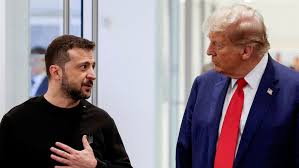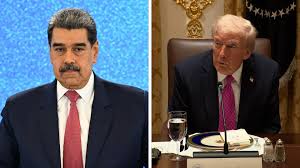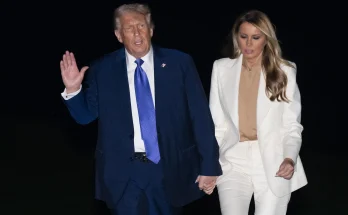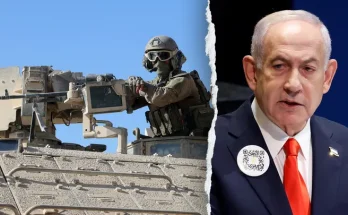It was supposed to be a day of hope — a step toward renewed cooperation, perhaps even a new chapter in U.S.–Ukraine relations. But when Volodymyr Zelenskyy walked into the White House on that gray October afternoon, he had no idea he was about to endure one of the most humiliating encounters of his political life.
The cameras captured the smiles, the handshakes, and the carefully orchestrated formalities. But behind the polished gestures, the meeting between Donald Trump and the Ukrainian president was filled with tension so thick it could be cut with a knife. What happened inside that room — and what didn’t — revealed a chilling shift in America’s stance toward Ukraine and a moment that left even seasoned diplomats speechless.
A Tie in Russian Colors

Observers might have missed it at first. But for those with a keen eye, the signal was unmistakable. Sitting across from Zelenskyy was Trump’s close ally and Fox News host Pete Hegseth, wearing a tie boldly patterned in
the colors of the Russian flag — red, white, and blue stripes in that precise order.
It wasn’t a coincidence. Moments before the meeting, Trump had taken a private phone call with Vladimir Putin — a conversation whose details remain undisclosed but whose influence was evident. Insiders later said Trump’s tone changed completely after that call. What was planned as a show of solidarity with Kyiv turned into a staged act of subtle defiance.
For Zelenskyy, the sight of that tie — gleaming under the Oval Office lights — must have felt like a punch to the gut. It was diplomacy turned into theater. And he was the unwilling audience.
The Promise That Vanished

Zelenskyy had come with a clear purpose: to secure long-range Tomahawk missiles for Ukraine’s defense. The weapons, he believed, could change the course of the war.
Just weeks earlier, Trump had hinted that such support was “under consideration.” But at the meeting, everything shifted. When Zelenskyy raised the request, Trump leaned back, folded his arms, and shook his head.
“We’re not looking to escalate,” he reportedly said.
The message was clear: there would be no Tomahawks, no guarantee of advanced air defense systems, and no further financial commitments. For a president fighting a brutal invasion, it was more than a policy setback — it was a personal blow.
The Ceasefire Proposal That Cut Like a Knife

Then came the most painful moment of all. Trump, after citing the need to “protect lives on both sides,” suggested that Ukraine consider a
ceasefire along current front lines — effectively freezing the conflict and leaving Russia in control of the territories it had seized.
Zelenskyy was stunned. To him, it sounded like surrender dressed as pragmatism. He pushed back, insisting that Ukraine could not abandon millions of citizens under occupation. But Trump was unmoved.
“Sometimes peace means compromise,” he replied.
The words hung in the air like smoke from a dying fire. For the Ukrainian leader, who had buried friends, soldiers, and civilians under Russian bombs, the phrase felt hollow — almost cruel.
The Meeting That Ended in Silence
When the session finally wrapped, Zelenskyy expected to proceed to a scheduled joint press conference — a symbolic moment to show unity before the cameras. But that, too, was suddenly cancelled.
White House staff cited “scheduling conflicts.” Yet everyone in the corridor could feel what had really happened: the warmth had frozen over. Trump reportedly ended the meeting abruptly, telling aides to “wrap it up.” Within minutes, the Ukrainian delegation was escorted out through a side entrance.
The much-anticipated U.S.–Ukraine mineral agreement, which was to be signed after the meeting, vanished from the agenda without explanation.
Outside, under a gray Washington sky, Zelenskyy faced reporters alone
. His face was drawn, his voice steady but heavy.
“We came seeking support and clarity,” he said. “We will continue to defend our country with what we have.”
Behind him, the American flag fluttered faintly — a silent witness to a friendship suddenly on pause.
What Went Wrong?
The official U.S. statement later described the talks as “constructive.” But insiders paint a darker picture. According to several diplomatic sources, Trump’s phone call with Putin just hours before the meeting dramatically changed his mood. He reportedly praised Russia’s “strategic patience” and questioned Ukraine’s “long-term viability.”
For Washington insiders, it was déjà vu — echoes of the first Trump-Zelenskyy scandal that triggered impeachment years earlier. But this time, there was no phone transcript, no public outcry — only the uneasy silence of realpolitik.
A Moment That Broke the Illusion
To many Americans watching from afar — especially those old enough to remember the Cold War — the scene was jarring. For decades, the United States stood as the world’s defender of democracy, the unshakable ally of nations under siege. Yet in that White House room, something felt inverted.
The tie.
The refusals.
The early exit.
Each detail told a story: that alliances can be transactional, that promises can evaporate with a phone call, and that dignity sometimes costs more than weapons.
A Solitary Figure Under the Flag
Hours later, as evening fell over Washington, Zelenskyy’s convoy left the White House gates. Cameras caught him staring out the window, lost in thought. It was the look of a man who had learned that friendship in politics can be conditional — and that even a handshake can carry the weight of betrayal.
He had come seeking missiles. He left with a lesson.
And somewhere inside the West Wing, a tie in Russian colors lay folded on a chair — a silent reminder of how diplomacy can wound without ever drawing blood.
Epilogue: A Question for America
For the generation that remembers Reagan’s “tear down this wall” moment, the question now lingers painfully:
When did America stop standing for those who refuse to kneel?
It wasn’t the weapons or the contracts that defined that meeting. It was the loss of something far deeper — the quiet erosion of moral leadership.
And in that silence, as Zelenskyy walked away from the White House, the world watched and wondered:
If the land of freedom can turn its back so easily, what hope remains for those still fighting for theirs?



